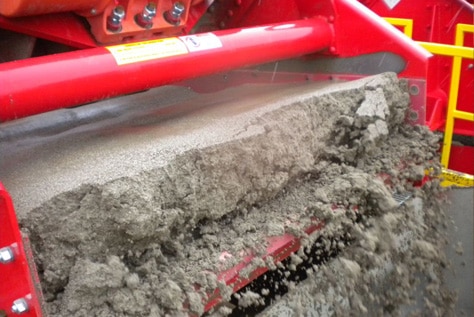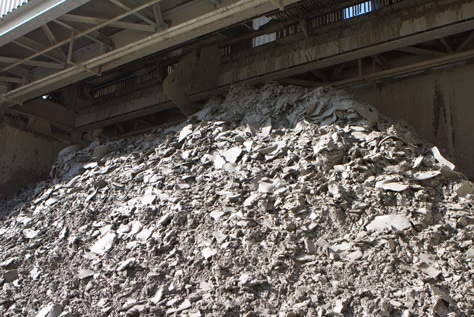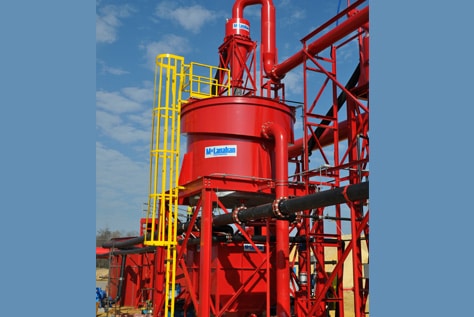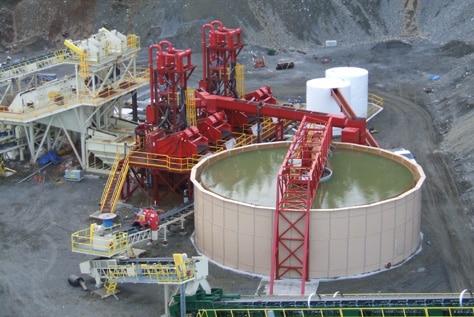Over the past several decades, washing and classifying equipment has evolved to include a newer selection that furthers the process to include dewatering, fines recovery and water management.
Like the classic lines of washing and classifying equipment, these pieces can be used in the production of sand, gravel and construction aggregates. Additionally, this equipment has also had a significant impact on the frac sand market, which has become increasingly prevalent in the past several years.Wet processing frac sand provides clean sand that is free of clays and falls in the range of size classifications required by the end user. This sand creates and maintains the passageways needed for harvesting natural gas and crude oil.The following looks at equipment pieces that are ideal for making the sharp classifications needed in frac sand processing, as well as other kinds of specialty sands and aggregates.If you would like to learn more about McLanahan’s fines recovery solutions, join us for a FREE Webinar on Tuesday, Dec. 11, 2018, at 2:30 PM EDT. This FREE webinar will give you a comprehensive overview of the four stages of fines recovery, fines handling, water management and water recycling in a typical wet processing aggregate operation. Register here: https://hubs.ly/H0fmVS50
|
|
Attrition Scrubbers
Attrition scrubbers, also known as attrition cells, are used to liberate deleterious material and remove it from competent aggregate material. They are also proven to liberate clays, reducing product turbidity, and to break apart loosely conglomerated clusters in frac sand plants. Attrition scrubbers can also be used in glass sand, frac sand, clay, and sand and gravel production, as well as in the preparation of flotation feeds and reagent washing.Attrition Scrubbers produce a high shear environment where particles scrub against themselves to scour their surface and liberate deleterious materials. All internal parts are completely rubber-lined to maximize wear life and minimize time and costs of replacement parts. The cells are typically fed by Separators™, hydrosizers or similar equipment that will prepare the material at a high density and achieve the best scrubbing action possible. |
|
|
Dewatering Screens
Dewatering Screens have a wide variety of applications including dewatering, desliming, degritting, rinsing, scrubbing and washing. They are designed to produce a consistent drip-free product, which is typically significantly drier than other dewatering equipment, such as fine material screw washers. Materials such as sand, gravel, crushed aggregates, frac sand, industrial sands, mineral sands, etc. are all capable of being processed through a dewatering screen.To dewater material effectively, slurry is fed onto a steep, downward inclined screen surface at the feed end of the dewatering screen to achieve rapid drainage. A pool of water begins to form in the valley as material builds up on the slightly upward inclined surface. Counter rotating motors create a linear motion, driving solids uphill, while liquid drains through the screen media. The uphill slope of the screen, along with a discharge weir, creates a deep bed that acts as a filter medium, allowing retention of material much finer than the screen openings.Where cleaner materials are required, cross dams and sprays can be included to assist with the washing process, liberating fines that pass through the media |
|
|
|
|
|
Filter Presses
Filter presses are ideal for producers looking to reduce or eliminate settling ponds, as well as those unable to receive permitting for new ponds. They provide aggregate, sand and mineral producers with a drier product than traditional belt presses, centrifuges or screw presses. Filter presses can also help with reclamation or reducing transportation and disposal costs of waste products.Recessed plate or membrane filter presses create a chamber for dewatering slurry without trapping cakes. This allows dewatered cakes to be discharged more easily than with traditional plate and frame presses. Recessed plates dewater using hydraulic pressure created from feed pumps, while membrane plates are designed to squeeze the cake once the chamber is full of slurry. The filter press then produces a dry, drip-free cake.This fully-automated system does not require operator assistance and in most cases, no additional chemicals are needed. |
|
|
Flat-Bottom Classifiers
Flat-bottom classifiers remove light-weight, deleterious materials, such as lignites and organics, from a <4 mesh (5mm) sand product stream. In a typical system, a flat-bottom classifier is fed by a hydrocyclone to provide a controlled, dense and deslimed feed. These classifiers are primarily used by aggregate producers in the production of construction sands, but can also be used in specialty sands production, including glass and frac sand, when organics are present.Flat-bottom classifiers are part of the family of hindered settling classification equipment. Operating on a batch discharge process, the pulse type discharge induces a jigging type action that helps dilate the bed and frees coarser organics to rise through the fluidized bed. Contaminated feed is divided into fine overflow and coarse streams; lightweight materials overflow with fine sand and are screened to separate the coarse light fraction from the fine sand. |
|
|
|
|
|
Hydrocyclones and Separators™
Hydrocyclones, or more simply cyclones, and variations such as Separators™ are used in a variety of applications including classification, desliming, fines recovery, densifying and dewatering. They can be used in industries such as sand, aggregates, hard rock mining and more. Hydrocyclones have become widely used in mineral processing because they are relatively inexpensive, process high volumes, take up minimal floor space and have no moving parts.Hydrocyclones are typically a cono-cylindrical shape with either a tangential or involute feed inlet configuration. Slurry enters the feed inlet at a designed pressure and volume. Independent of the shape or configuration of the inlet, slurry follows the fall of the upper cylinder, resulting in a swirling action. Centrifugal forces send coarser material to the outer wall to travel downward and be further accelerated in the conical sections. These coarser fractions then exit through the apex, or spigot, at the bottom of the hydrocyclone. Finer fractions remain rotating around with the fluid and are removed with the upward swirling flow through the vortex finder.Separators™ differ from conventional hydrocyclones in that a rubber underflow regulator, sometimes called a fishtail, is fitted to the apex and an overflow pipe of specific size and length is fitted to the overflow flange. The overflow pipe returns below the apex and creates a siphon that closes the regulator. An air valve is fitted to the overflow pipe and air is bled in to regulate the amount of siphon generated. This configuration allows consistent underflow density regardless of feed density, which in aggregate operations is a common occurrence. This benefits any moisture sensitive downstream process such as stockpiling and attritioning. This design can also provide the operator some fine tuning adjustment in the production gradation, which would otherwise not be available. |
|
|
Hydrosizers/Density Separators
When extremely sharp classification is needed to separate -4 mesh (5mm) granular material by size, Hydrosizers™, also known as density separators, are comparable to screening, but at a fraction of the footprint and cost. A producer who needs tight control over classification or wishes to separate minerals of two different specific gravities would be an ideal candidate for a Hydrosizer™.Hydrosizers™ can be used in a wide variety of industries including construction and specialty sands, frac sand, aggregates, minerals sands, and other ore concentrates. It is perhaps the only piece of processing equipment suitable to make the discrete cuts that meet the needs of frac sand production. They can be combined with other equipment such as hydrocyclones, Separators™, pumps, attrition cells, dewatering screens, thickeners and filter presses to offer complete wet processing plants.To make its extremely sharp classification, Hydrosizers™ use hindered settling technology. Feed material enters the top of the unit via a central feed well, after which water is inject and creates an upward rising current. This establishes a zone of suspended, or teetered, solids. Fines then flow over a weir at the top of the unit, while coarse solids collect in the lower cone. |
|
|
|
|
|
Thickeners
Thickeners, also known as clarifiers, recover immediately reusable process water, as well as extract fines and other materials from water. They can be used by aggregate producers, as well as by environmental contractors in industries such as wastewater management. Thickeners are especially beneficial in areas where water is in short supply or very expensive; when re-circulated water is not suitable for reuse in a plant; where ponds are located on minable reserves; or where ponds must be reduced in size due to permitting issues.High-rate thickeners separate liquids from solids using hindered settling. Rotating rake arms collect settled sludge and move it toward the center discharge cone. They use minimal amounts of polymers/chemicals in order to drop the solids, making it environmentally friendly.Deep cone, or paste, thickeners are meant to achieve the highest solids concentrations possible through gravity separation. The resulting mud, or paste, is often so dense that no further separation of water and solids can be achieved. Pastes are then moved to impoundment structures or processed further through filter presses. Fed from the top, deep cone thickeners originally rely on the process of free-settling. After the fines reach a certain point in the process they continue to thicken through hindered settling. Depending on the characteristics of the material a deep cone thickener can be designed with no moving parts, or with pickets (rakes) that rotate slowly to create channels in the mud, releasing water. |
|
|
Complete Solutions – A Systems Approach
This newer, comprehensive line of wash equipment has been especially useful to the industry when put together to create a complete system. Ultra Sand Plants, which combine Separators™, dewatering screens and a slurry pump, can provide a 3-5 percent higher product yield over traditional fine material screw washers. With the use of a dewatering screen, they produce a drier product and do not have the inherent inefficiencies of screw washers. Ultra Sand Plants operate efficiently, sending unwanted fines to waste streams, while keeping product sized fines in the product piles.Another system, the Ultra Fines Recovery System, or UFR, is capable of recovering solids down a nominal -400 mesh (38 microns) and finer. They are typically made of small diameter cyclones and dewatering screens. UFRs give producers maximum fines recovery for a saleable product, reduce pond maintenance, and require no flocculant.As with any piece of equipment, it’s important to make sure that systems are properly sized and engineered for a producer’s particular processing and material needs. Reputable companies will be happy to work with you from testing to set-up and installation. |
|
Request For Additional Information:
|


















